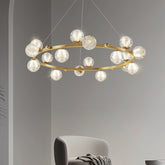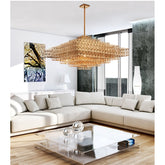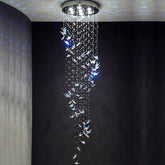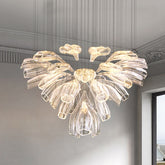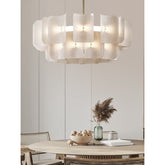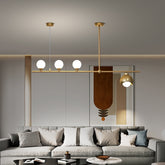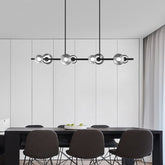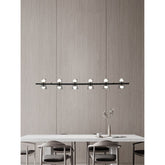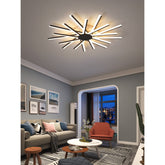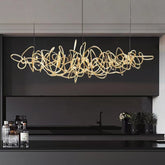The Magic of Mirrors and Lighting - Techniques to Amplify Light in Your Home
Light has an incredible ability to alter our perception of space, making rooms appear larger, more open, and more inviting. By mastering a few simple techniques, you can harness this power to brighten up even the darkest corners of your home. Whether you're dealing with a small, dim apartment or looking to enhance the ambiance of a spacious living area, the strategic use of mirrors and lighting can make all the difference.
Imagine stepping into a room that feels instantly uplifting, warm, and welcoming. The kind of space where natural light bounces playfully off surfaces, creating a vibrant and airy atmosphere. This transformation isn't just a dream; it's the magic of effectively using mirrors and lighting to amplify light in your home.
In this article, we will explore various techniques to amplify light in your home. From the strategic placement of mirrors to choosing the right lighting fixtures, these methods will help you create a brighter, more inviting atmosphere in any space. Get ready to transform your home into a haven of light and warmth with these practical and stylish tips.
Understanding the Basics of Light Amplification
Importance of Natural Light
You see, natural light is more than just a visual enhancer; it's a powerful element that significantly impacts our mood and energy levels. Exposure to natural light boosts serotonin production, which can improve our mood and help regulate our sleep-wake cycle. Sunlight also helps our bodies produce vitamin D, essential for bone health and immune function. Beyond health benefits, natural light makes spaces feel larger, more open, and more welcoming. Rooms bathed in sunlight tend to have a more vibrant and positive atmosphere, making them more enjoyable to spend time in.
Role of Artificial Light
While natural light is invaluable, it's not always available or sufficient, especially during darker months or in spaces with limited windows. This is where artificial lighting steps in to play a crucial role. Artificial light not only complements natural light by filling in when sunlight is scarce but also allows for control over the intensity and direction of light within a space.
Artificial lighting can be tailored to meet specific needs and preferences. For instance, ambient lighting provides general illumination, ensuring a room is evenly lit, while task lighting focuses on areas where activities like reading or cooking take place. Accent lighting highlights architectural features or artwork, adding depth and interest to a room.
The combination of natural and artificial light creates a balanced and versatile lighting scheme. By understanding how to harmonize these sources, you can maximize brightness and create a cohesive, inviting environment that adapts to different times of day and uses.
The Magic of Mirrors
Strategic Placement of Mirrors
Opposite Windows:
One of the simplest yet most effective ways to amplify light in your home is by placing mirrors opposite windows. This technique allows mirrors to catch and reflect natural light, bouncing it back into the room. By doing so, you can double the amount of light entering the space, making it appear brighter and more open. This is especially useful in rooms with limited windows or those that receive less direct sunlight.
Hallways and Dark Corners:
Hallways and corners are often the darkest parts of a home, but strategic mirror placement can transform these spaces. By positioning mirrors at the end of a hallway or in a dim corner, you can reflect existing light from adjacent rooms or artificial sources. This not only brightens the area but also creates an illusion of extended space, making narrow hallways feel more spacious and dark corners less oppressive.
Types of Mirrors
Wall Mirrors:
Wall mirrors are ideal for expansive light distribution. Large mirrors, whether full-length or oversized wall-mounted designs, can capture and reflect more light across a room. They are particularly effective in living rooms, dining areas, and bedrooms where you want to maximize brightness and create a sense of openness.
Decorative Mirrors:
Decorative mirrors serve a dual purpose: they add a stylish element to your decor while enhancing light. These mirrors come in various shapes, sizes, and designs, allowing you to incorporate them into your home as both functional and artistic pieces. They work well in any room, adding a touch of elegance and sophistication while contributing to the overall light scheme.
Mirror Shapes and Frames
Shapes:
The shape of a mirror can influence how light is reflected and dispersed. Round mirrors, for instance, can create a softer, more diffused light, perfect for adding a gentle glow to a room. Rectangular and square mirrors provide a more direct reflection, ideal for maximizing light in larger areas. Unusual shapes, like hexagons or abstract designs, can add visual interest while still contributing to light amplification.
Frames:
Choosing the right frame for your mirror is crucial in blending it with your decor while enhancing light. Thin, metallic frames can create a sleek, modern look that doesn’t detract from the mirror’s reflective properties. On the other hand, ornate or wooden frames can add a touch of traditional or rustic charm. The key is to select frames that complement your interior design style while not overshadowing the mirror’s ability to reflect light effectively.
Mastering Lighting Techniques
Layered Lighting
Ambient Lighting:
Ambient lighting provides the foundational illumination for any room, ensuring overall brightness. This type of lighting includes ceiling fixtures like chandeliers, pendant lights, and recessed lights. Ambient lighting sets the general tone and level of light in a space, making it essential for creating a welcoming environment. Choosing fixtures that distribute light evenly helps avoid dark spots and shadows, giving your room a cohesive and well-lit appearance.
Task Lighting:
Task lighting is all about functionality. It focuses light on specific areas where activities such as reading, cooking, or working are performed. Examples of task lighting include desk lamps, reading lamps, under-cabinet lights in kitchens, and vanity lights in bathrooms. This targeted approach ensures that you have adequate light for detailed tasks, reducing eye strain and enhancing productivity.
Accent Lighting:
Accent lighting adds depth and drama to a room by highlighting architectural features, artwork, or decorative objects. This type of lighting is more focused and intense, drawing attention to specific areas or items. Examples include track lighting, wall-mounted fixtures, and spotlights. By using accent lighting, you can create visual interest and add layers of light that contribute to a dynamic and inviting atmosphere.
Choosing the Right Bulbs
LED vs. Incandescent:
When selecting light bulbs, consider the differences between LED and incandescent options. LEDs are more energy-efficient, consuming less power and lasting significantly longer than incandescent bulbs. They produce less heat and are available in a wide range of color temperatures and brightness levels. Incandescent bulbs, while less energy-efficient, offer a warm, familiar glow that some people prefer for its cozy and comforting ambiance.
Color Temperature:
The color temperature of a light bulb affects the ambiance of a room. Measured in Kelvins (K), color temperature ranges from warm (yellowish) to cool (bluish) light. Warm light (around 2700K to 3000K) creates a relaxing and inviting atmosphere, ideal for living rooms and bedrooms. Cool light (around 5000K to 6500K) is more energizing and is suitable for task-oriented spaces like kitchens and home offices. Choosing the right color temperature can enhance the mood and functionality of each room in your home.
Using Dimmers
Adjustable Lighting:
Dimmers offer the flexibility to adjust the brightness of your lights, allowing you to create different moods and save energy. They are particularly useful in living rooms, dining areas, and bedrooms, where lighting needs can vary throughout the day. With dimmable lights, you can easily transition from bright, functional lighting to soft, ambient illumination, enhancing the comfort and versatility of your space.
Installation Tips:
Incorporating dimmers into your existing lighting setup is a straightforward process. Here are some easy steps to follow:
- Choose Compatible Bulbs: Ensure your bulbs are dimmable and compatible with your dimmer switch.
- Turn Off Power: Always turn off the power at the circuit breaker before starting any electrical work.
- Remove Existing Switch: Carefully remove the existing light switch, taking note of the wiring configuration.
- Install Dimmer Switch: Connect the dimmer switch according to the manufacturer's instructions, matching the wires from the dimmer to the wires in the wall.
- Test the Dimmer: Once installed, turn the power back on and test the dimmer to ensure it operates smoothly and adjusts the light levels as desired.
Combining Mirrors and Lighting for Maximum Effect
Mirror and Light Pairing
Mirror Behind Lamps:
Placing mirrors behind table lamps is a simple yet powerful way to amplify light in your home. When a lamp is positioned in front of a mirror, the mirror reflects the light emitted, effectively doubling the illumination in that area. This technique not only brightens the space but also adds a decorative touch, making it perfect for side tables in living rooms, bedside tables in bedrooms, and console tables in hallways.
Mirrored Light Fixtures:
Mirrored light fixtures combine functionality with elegance, offering an additional source of reflection. These fixtures often feature reflective surfaces that enhance the light output, creating a more radiant effect. Chandeliers with mirrored elements, wall sconces with polished chrome finishes, and pendant lights with reflective interiors can all contribute to a brighter, more visually appealing space. By incorporating these types of fixtures, you can add both style and increased light to any room.
Creating Illusions with Light and Reflection
Spaciousness:
Mirrors and lighting can work together to create the illusion of spaciousness in small rooms. Large wall mirrors or mirrored panels reflect light and surrounding elements, making a room appear larger and more open. Pairing these mirrors with strategically placed lights, such as overhead fixtures or floor lamps, enhances this effect. The combination of light and reflection can visually push back walls, creating a sense of expanded space even in compact areas like small living rooms or cozy bedrooms.
Depth Perception:
In narrow spaces, such as hallways or small entryways, mirrors and lighting can be used to add depth and dimension. By placing a mirror on one side of a hallway and directing a light source, like a sconce or recessed light, towards it, you create a reflective path that elongates the space. This technique tricks the eye into perceiving a greater depth, making the area feel less confined. Additionally, using mirrors with unique shapes or decorative frames can add an artistic element, further enhancing the visual interest of the space.
Practical Tips and DIY Ideas
DIY Mirror Projects
Framing Plain Mirrors:
Upgrading plain mirrors with decorative frames is an easy and cost-effective way to add style and enhance light reflection. Here are a few simple methods:
- Wooden Frames: Purchase pre-made wooden frames from a craft store, or make your own using wooden trim and a mitre box. Paint or stain the wood to match your decor before attaching it to the mirror with adhesive or brackets.
- Reclaimed Materials: Use reclaimed materials like old window frames, barn wood, or vintage picture frames for a rustic, unique look. Sand and clean the materials, then attach them around your mirror for a custom touch.
- DIY Mosaic Frames: Create a mosaic frame using broken tiles, glass pieces, or seashells. Arrange the pieces around the mirror’s edges and secure them with strong adhesive. Fill in the gaps with grout to complete the look.
Mirror Collages:
Creating a wall of mirrors can amplify light and add an artistic focal point to any room. Here’s how to get started:
- Gather Mirrors: Collect mirrors of various shapes, sizes, and styles. Thrift stores and flea markets are great places to find inexpensive options.
- Layout Design: Plan your layout on the floor first, experimenting with different arrangements until you find a pleasing composition. Aim for a balanced mix of sizes and shapes.
- Mounting: Use picture hangers or adhesive wall hooks to mount each mirror. Start with the largest mirror in the center and work your way outwards, adjusting the placement to ensure even spacing and alignment.
Lighting Upgrades on a Budget
Affordable Lighting Fixtures:
Stylish lighting fixtures don’t have to break the bank. Here are some budget-friendly options.
- Pendant Lights: Simple pendant lights can add elegance to dining areas or kitchen islands. Look for minimalist designs in materials like glass or metal that provide a modern touch without high costs.
- Table Lamps: Thrift stores and online marketplaces often have a wide selection of affordable table lamps. Look for unique bases and shades that can add personality to your space.
- DIY Fixtures: Create your own lighting fixtures using items like mason jars, wire baskets, or vintage colanders. With some basic electrical components, you can craft a one-of-a-kind light that suits your decor.
Smart Bulbs:
Smart bulbs are an excellent way to control light intensity and color without a significant investment. Here’s why they’re worth considering:
- Adjustable Settings: Smart bulbs can be dimmed or brightened via a smartphone app, allowing you to create the perfect ambiance for any situation.
- Color Options: Many smart bulbs offer a range of color temperatures and hues, from warm whites to vibrant colors. This flexibility allows you to change the mood of a room with a simple tap.
- Energy Efficiency: Smart bulbs are typically LED, which means they’re energy-efficient and long-lasting. They can help reduce your energy bills while providing versatile lighting solutions.
- Voice Control: If you have a smart home system, you can integrate smart bulbs for voice control. This convenience adds a modern touch to your home, making it easy to adjust lighting without lifting a finger.
Final Words
Now that you have a wealth of techniques at your disposal, it’s time to start experimenting in your own home. Don’t be afraid to try different mirror placements, combine various types of lighting, and get creative with DIY projects. Each home is unique, and with a bit of experimentation, you can find the perfect balance of light and reflection that suits your style and enhances your living spaces. We’d love to see how these ideas transform your home! Your creativity and experiences can inspire others to brighten their spaces as well. Let’s create a brighter, more inviting world together, one home at a time.












































































































